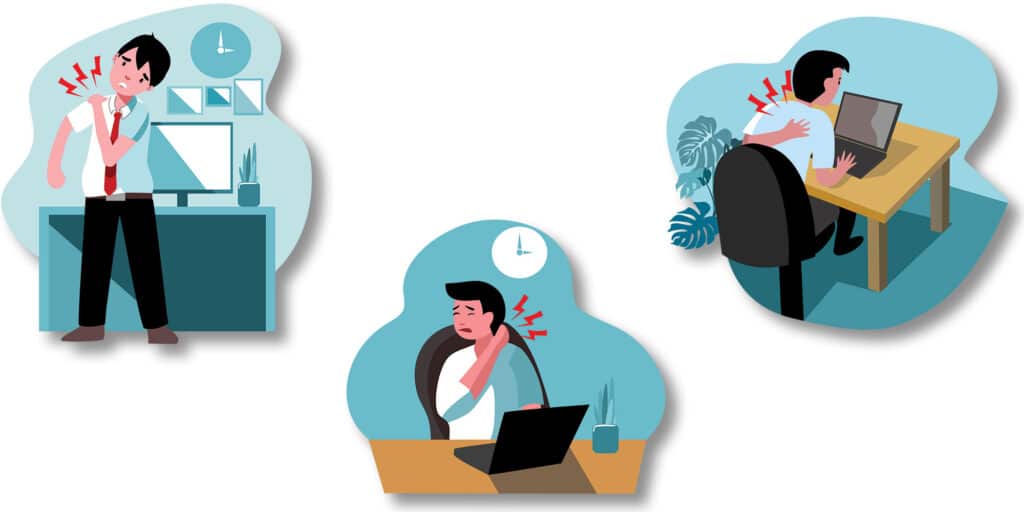Are you starting to worry about lower back pain? You are not alone… More than 80 percent of Americans experience lower back pain at some point in their lives. For most of us, mild back discomfort is just a part of the aging process.
However, for some people, red flags may indicate something more serious than everyday aches and pains. So, how do you know if your pain is routine or not? And when should you worry about lower back pain?
Understanding Back Pain
 According to the National Institute of Health, back pain is the fifth leading cause of trips to doctors’ offices. Yet, despite all the advancements in medicine over the last few decades, it’s still hard to identify back pain causes.
According to the National Institute of Health, back pain is the fifth leading cause of trips to doctors’ offices. Yet, despite all the advancements in medicine over the last few decades, it’s still hard to identify back pain causes.
There’s no exact reason why some people suffer from back pain while others don’t. Genetic and environment definitely contribute to is development, and stress is a common trigger. But some people who sustain injuries and have stress may never develop back pain, while others never get a back injury and find themselves with chronic back pain.
We do know that injury is the most common cause of lower back pain. This includes muscle sprains and strains during sudden movements.
Low back pain can also result from other causes, including:
- Arthritis
- Endometriosis
- Fibromyalgia
- Kidney infection
- Kidney stones
- Poor posture
- A ruptured or herniated disc
- Sciatica
- Spinal cord cancer
- Spinal infection
- Spinal stenosis
- Sprains
Sub-Acute vs. Chronic Back Pain


On the other hand, chronic pain lasts for 12 weeks or longer. Moreover, the symptoms will not go away on their own and will require treatment.
To further complicate things, research has shown a link between sub-acute and chronic back pain. 20% of Americans suffering from sub-acute symptoms will experience chronic pain within the year. This is because they do not receive treatment for early warning signs, which develop into long-term back problems.
In short, it’s important to look at your back pain issues. Even if your back pain is somewhat recent, it’s a good idea to have your doctor take a look. It could well be a minor problem that will go away on its own, but it never hurts to be careful.
What Are the Symptoms of Lower Back Pain?


- Tingling or numbing sensation that rotates between low back to legs and feet.
- Burning pain sensation that travels from the low back to hip and thigh regions.
- Muscle stiffness and spasms in the lower back, pelvis, or hips.
- Soreness that intensifies after sitting or standing.
- Muscle cramps or spasms around the back.
- Inability to stand up or sit down with ease after bending down.
- Persistent pain that intensifies during physical activity.
Both sub-acute and chronic back pain share these symptoms. Thankfully, many of these issues can be managed through rest and at-home remedies. However, they do all indicate that there may be a larger issue.
When to See a Doctor
In general, back pain should resolve itself within a few weeks. Pain lasting longer than a month is a sign that something may need treatment. Schedule an office visit with your doctor if you answer yes to any of these questions:
- Has your pain not improved after a week of at-home treatment?
- Is there constant, intense pain at night or when you lie down?
- Does pain spread through one or both legs? Does it extend below the knee?
- Are you experiencing numbness or tingling in either/both legs?
- Have you had unexplained weight loss?
- Is there swelling or redness on your back?
You should seek immediate medical attention if your lower back pain:
- Results from trauma such as a car accident, fall, injury or medical emergency.
- Occurs alongside a fever.
- Causes bladder or bowel control issues.
In some cases of mild back pain, you may still want to see a doctor if it’s causing issues like insomnia or an inability to do daily activities. Problems like these can disrupt your quality of life and cause the condition to worsen if left unattended.
Lower Back Pain: Diagnosis & Treatment


Doctors often perform a reflex check. This can determine if your lower back pain is the result of nerve damage or another issue.
If you’re experiencing more serious symptoms of low back pain, your doctor will likely perform additional tests. Imaging tests like CT Scans, MRIs, and X-Rays will allow your doctor to check for bone and ligament issues.
Finally, if your doctor suspects spinal or nerve damage as the cause of pain, they may conduct an electromyography (EMG) test to diagnose specific conditions.
Managing Lower Back Pain
Lower back pain results from numerous conditions. However, there is an overlap in pain management strategies.
For mild low back pain, your doctor will recommend a series of self-care treatments. This usually includes rest, limited physical activity, and a moderate dose of NSAID medications.
For lower back pain caused by a sedentary lifestyle, stress, and environmental factors, you should take steps to become more active. Incorporate more exercise into your life. If you sit a lot at work, look into ergonomic office accessories. And find healthy ways to manage your stress.
For more serious lower back pain, your doctor may prescribe medications like:
- Anti-inflammatories
- Muscle relaxants
- Pain relievers
- Corticosteroids injections
These medications are combined with different forms of physical therapy. This includes massage, back strengthening exercises, and stretching to build flexibility and strength.
If these pain management therapies are not effective, your doctor may advise surgery. Doctors reserve this only for the most serious causes of back pain. This includes conditions that result in a loss of bladder control, severe spinal injury, and/or nerve damage.
Do I Need to Worry About Lower Back Pain?
Lower back pain is common among adults. However, most people can manage it at home with exercise, lifestyle changes, and medication.
If your pain has become chronic or it’s associated with more complicated symptoms, you should seek professional medical help. But you don’t need to worry. Many conditions can be managed through therapy and other clinical treatments.
When it comes to back pain, the sooner you act, the better. If you are suffering from back pain, consult with your doctor to see what you can do to improve your health and happiness.
What did you do when you realized you had lower back pain?
Tell us your story in the comments.
What back pain topics should we cover next?
Email us at info@painresource.com with your ideas.
Are you on Facebook?




